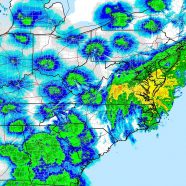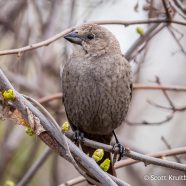Hurricane Matthew & Migration
First of all, my thoughts are with all who were or are experiencing the very worst of Hurricane Matthew, a deadly tropical cyclone that has been ravaging areas from Haiti to Cuba, the Bahamas, and now the United States. I, like you undoubtedly, know people who took some of the heavy blows from the storm in Florida, Georgia, South Carolina and North Carolina. It proved to be a very difficult forecast which only exacerbated fears, and as heavy rain falls right now in the Mid-Atlantic and New England before the post-tropical cyclone heads out to sea instead of taking that long-discussed loop,...
Read MoreBrown-headed Cowbird Nestling
This spring and summer seem to have been very successful for the Brown-headed Cowbird. I realize that this is largely anecdotal, but I have had and heard a lot of sightings and stories about various species discovered feeding a hatchling or fledgling Cowbird. From the American Redstart to the Chipping Sparrow, the Yellow-throated Vireo or the Yellow Warbler, an Orchard Oriole and a Common Yellowthroat, a Blue-winged Warbler or this nest that I found and photographed a couple of weeks ago, it has been Cowbirds here, there, and everywhere. What’s the common thread? All of these birds and...
Read MoreBrown-headed Cowbirds
We seem to be at the peak season of reports of, “Why is this pretty bird feeding this huge baby bird that is twice its size?!” all thanks to the native Brown-headed Cowbird (Molothrus ater). Here we have a photo of a male followed by a female. The species is a brood parasite with the female laying eggs in nests of other birds to leave the burden of raising young to these unsuspecting parents by fooling them into thinking it is their own egg. It is also a rather clever way of not putting all of your eggs in one basket. These blackbirds are found in typical types of blackbird...
Read MoreMelanistic House Sparrow (Passer domesticus)
This is one House Sparrow (Passer domesticus) I have never seen before! I took these shots last weekend, the bird being part of a group of well over 100 House Sparrows. The photos are very true to real life appearance and have not been heavily edited. Do you know why it is so dark? It appears to be melanistic which means that the dark-colored pigment melanin in the feathers was produced at higher than normal levels creating an abnormal color. The opposite is known as leucism where pigments are produced at less than normal levels or in an unexpected pattern. Melanism in small songbirds is...
Read MoreThanksgiving is coming
Thanksgiving is coming…what do you think this face says to you? Thanks for the look, Turkey.
Read More








